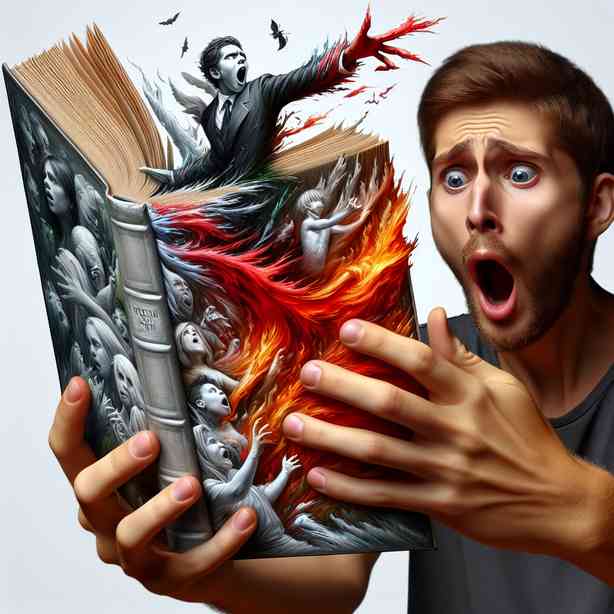
There are certain moments in literature that remain etched in our minds, scenes that profoundly affect our perception of a story, its characters, and sometimes even our own lives. These moments, often referred to as “that scene that made you close the book,” can elicit a range of emotions—from shock and despair to joy and reflection. In this detailed exploration, we will delve into the significance of such scenes in literary works, their impact on readers, and the reasons one might choose to momentarily set aside a book in response to these powerful moments.
Scenes that evoke a strong emotional response often serve as pivotal turning points within a narrative. They can expose the vulnerabilities of characters, reveal hidden truths, or challenge the moral fabric of the story. For instance, in many classic works, there are scenes that depict the irrevocable loss of innocence or the stark reality of human suffering. These moments not only resonate with the characters involved but also challenge readers to confront their beliefs, biases, and emotions.
Take, for example, the moment in Harper Lee’s “To Kill a Mockingbird” when Boo Radley finally emerges from the shadows to save Scout and Jem. This scene encapsulates themes of empathy, understanding, and the complexities of human behavior. As Boo takes action to protect the children, readers are reminded of the importance of looking beyond preconceived notions and societal judgments. This emotional revelation may lead some readers to close the book momentarily to process the weight of these themes, reflecting on their implications in their own lives.
Similarly, in Khaled Hosseini’s “The Kite Runner,” the pivotal scene where Amir confronts his childhood betrayal of Hassan serves as a catalyst for deep introspection. The emotional turmoil that Amir experiences forces readers to consider the nature of guilt and redemption. Readers may find themselves pausing, contemplating their personal experiences with regret and the quest for forgiveness, thus solidifying the moment as a defining scene within the narrative.
The decision to close a book during such intense moments often stems from an overwhelming need to absorb and reflect on the emotions that are unearthed. Literature has the unique capacity to tap into our collective consciousness, drawing out feelings that we may have buried or ignored. When a scene strikes a chord, causing a visceral reaction, it becomes essential for many readers to step back and engage with those feelings, allowing the weight of the scene to settle within their minds.
Another vital component of these scenes is their ability to mirror real-life experiences. Often, readers encounter moments in literature that resonate with their own challenges or triumphs. This mirroring effect can amplify the emotional response, creating a shared sense of humanity. In George Orwell’s “1984,” the scene where Winston faces the reality of betrayal and the loss of personal freedom can prompt readers to reflect on their own societal roles and the importance of truth. Such reflections might lead readers to set the book down as they grapple with the implications of living in a world where autonomy and individuality are stripped away.
Moreover, the impact of these scenes extends beyond the momentary emotional reaction; they can influence the way readers perceive the world around them. A powerful scene can ignite a spark of social awareness, prompting individuals to engage in conversations about critical issues such as injustice, inequality, and the human condition. For instance, in “The Handmaid’s Tale” by Margaret Atwood, the harrowing scenes depicting life under an oppressive regime can evoke a sense of urgency among readers, compelling them to contemplate the fragile nature of freedom and the importance of standing against tyranny.
The narrative structure also plays a crucial role in delivering these impactful moments. Authors often build up tension and character development leading to a climactic scene that serves as a fulcrum for the story. This careful crafting ensures that when the moment arrives, it is loaded with meaning, making the reader’s decision to pause the book feel justified. In “The Great Gatsby,” the moment of Gatsby’s tragic realization about the limitations of his dreams prompts readers to reflect on the nature of ambition and the American Dream. The poignancy of this scene compels readers to consider the dissonance between aspiration and reality, often leading them to step back and ponder the implications.
In conclusion, those scenes that make readers close the book are not merely interruptions in the narrative; they are integral to the fabric of storytelling. They invite readers into a deeper understanding of themselves, their society, and the universal experiences that connect us all. By providing moments that challenge, evoke, and inspire, literature holds a mirror to our lives, presenting us with opportunities for growth and reflection. The emotional journeys ignited by these powerful scenes may lead us to pause, explore our internal landscapes, and ultimately return to the text with a renewed perspective. Thus, while the act of closing a book may signify a moment of overwhelm, it is also a testament to the profound effect that literature can have on our hearts and minds.


